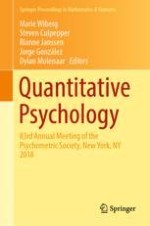2019 | OriginalPaper | Buchkapitel
Comparison of Three Unidimensional Approaches to Represent a Two-Dimensional Latent Ability Space
verfasst von : Terry Ackerman, Ye Ma, Edward Ip
Erschienen in: Quantitative Psychology
Aktivieren Sie unsere intelligente Suche, um passende Fachinhalte oder Patente zu finden.
Wählen Sie Textabschnitte aus um mit Künstlicher Intelligenz passenden Patente zu finden. powered by
Markieren Sie Textabschnitte, um KI-gestützt weitere passende Inhalte zu finden. powered by
